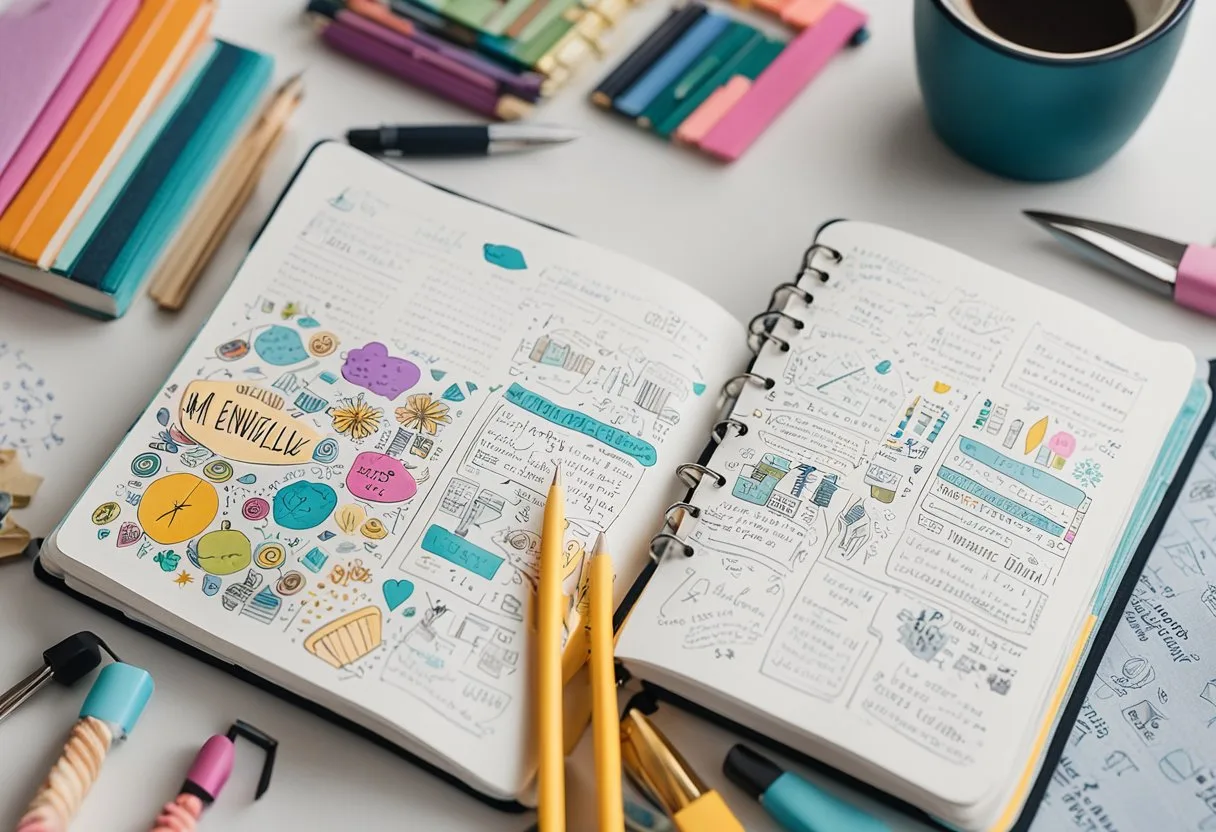Bullet journaling has become a popular and effective way to stay organized and productive in today’s fast-paced world. It’s a personalized system that allows individuals to track their daily tasks, goals, habits, and much more in a creative and fun way. With endless possibilities, bullet journaling can be tailored to fit anyone’s needs and preferences. In this blog post, we will discuss the concept of Bullet Journal Ideas and share with 25 Bullet Journal Ideas ideas to help you start
Whether you’re a beginner or an experienced bullet journaler, there are always new ideas and inspiration to explore. From simple layouts to complex spreads, there are countless ways to make your bullet journal unique and functional. With the help of online resources and communities, such as The Spruce and Mint, you can find a variety of bullet journal ideas and tips to enhance your productivity and creativity.
Getting Started with Bullet Journaling
Bullet journaling is a flexible and customizable system for organizing your life. It allows you to keep track of your tasks, appointments, and goals in a single notebook. Here are some tips to help you get started with bullet journaling.
Choosing Your Bullet Journal
The first step in starting a bullet journal is choosing the right notebook. You can use any notebook you have on hand, but it’s best to choose one that is durable and has enough pages to last you a few months. Some popular options include the Leuchtturm1917, Moleskine, and Rhodia notebooks.
Basic Bullet Journal Layouts
Once you have your notebook, it’s time to start designing your bullet journal layouts. The basic layout consists of a future log, monthly log, and daily log. The future log is where you can write down important dates and events that will happen in the next six months to a year. The monthly log is where you can write down tasks and appointments for the current month. The daily log is where you can write down tasks and appointments for each day.
Bullet Journal Key
The bullet journal key is an essential part of the system. It’s a set of symbols that you use to categorize your tasks and appointments. Some popular symbols include a bullet for tasks, a circle for appointments, and a star for important tasks. You can also create your own symbols to fit your needs.
Starting a bullet journal can be a fun and rewarding way to stay organized. By choosing the right notebook, designing your layouts, and using a bullet journal key, you can create a system that works for you. With a little practice and patience, you can become a bullet journaling pro in no time.
Setting Up Your Goals
Setting up goals is an essential part of bullet journaling. It helps individuals to define their objectives and work towards achieving them. In this section, we will discuss how to set up your long-term and short-term goals using bullet journaling.
Long-Term Goals
Long-term goals are those that take more than a year to achieve. These goals require careful planning and dedication. To set up long-term goals in your bullet journal, you can create a separate section for them. In this section, you can list down all your long-term goals and break them down into smaller achievable steps.
One way to organize your long-term goals is to use a table format. Create a table with columns for the goal, the steps required to achieve it, and the deadline. This will help you track your progress and stay on top of your long-term goals.
Short-Term Goals
Short-term goals are those that can be achieved within a few weeks or months. These goals are more manageable and can help you build momentum towards your long-term goals. To set up short-term goals in your bullet journal, you can create a separate section for them.
One way to organize your short-term goals is to use a list format. Create a list of all your short-term goals and prioritize them based on their importance. You can also assign deadlines to each goal to help you stay on track.
Setting up your goals is an important part of bullet journaling. By using the right format and organization, you can break down your long-term and short-term goals into achievable steps. This will help you stay motivated and focused on achieving your objectives.

Organizing Your Month
When it comes to bullet journaling, organizing your month is a crucial part of the process. By setting up a monthly calendar and identifying important deadlines, you can stay on top of your schedule and ensure that you don’t miss any important events or appointments.
Monthly Calendar Setup
One of the most important aspects of organizing your month is setting up a monthly calendar. This can be done in a variety of ways, depending on your personal preferences and needs. Some people prefer to use a traditional calendar layout, while others opt for a more creative approach.
Regardless of the layout you choose, it’s important to include all of the important dates and events for the month. This can include birthdays, anniversaries, appointments, meetings, and any other important deadlines or events.
To make your monthly calendar more visually appealing, consider using different colors or symbols to differentiate between different types of events. This can help you quickly identify important dates and ensure that you don’t miss anything.
Important Deadlines
In addition to setting up a monthly calendar, it’s also important to identify any important deadlines for the month. This can include work deadlines, project due dates, or any other important tasks that need to be completed by a specific date.
To keep track of these deadlines, consider setting up a separate page or section in your bullet journal specifically for this purpose. You can use a simple list format to keep track of each deadline, or you can get more creative and use a visual layout to help you stay organized.
Regardless of the format you choose, be sure to include all of the important details for each deadline, including the due date, the task that needs to be completed, and any other relevant information.
By setting up a monthly calendar and identifying important deadlines, you can stay organized and on top of your schedule. With a little bit of planning and creativity, you can create a bullet journal that helps you stay on track and achieve your goals.
Weekly Planning
Weekly planning is an essential aspect of bullet journaling. It helps you to stay organized, set goals, and track your progress. There are various ways to plan your week, and each method offers different features that cater to your needs. This section will explore two of the most popular weekly planning methods in bullet journaling: weekly spread ideas and habit tracking.
Weekly Spread Ideas
A weekly spread is a page in your bullet journal that allows you to plan your week in advance. It typically includes a calendar, task list, and notes section. Weekly spreads can be customized to suit your preferences and needs. Some popular weekly spread ideas include:
- Minimalist spread: This spread is simple and clean, with only essential information included. It is perfect for those who prefer a no-fuss approach to planning.
- Themed spread: A themed spread is a great way to add some fun and creativity to your weekly planning. You can choose a theme that reflects your personality or interests.
- Color-coded spread: This spread uses different colors to categorize tasks and events. It is an excellent way to stay organized and visually track your progress.
Habit Tracking
Habit tracking is a powerful tool that helps you to form good habits and break bad ones. It involves setting goals and tracking your progress over time. Habit tracking can be incorporated into your weekly planning by creating a habit tracker in your bullet journal. Some tips for effective habit tracking include:
- Start small: Begin with a few simple habits and gradually add more as you progress.
- Be consistent: Track your habits every day, and try not to miss a day.
- Celebrate your progress: Celebrate your successes, no matter how small they may seem.
Weekly planning is an essential part of bullet journaling. It helps you to stay organized, set goals, and track your progress. With the right weekly spread ideas and habit tracking methods, you can achieve your goals and create positive habits that last a lifetime.
![]()
Daily Productivity
When it comes to daily productivity, bullet journals can be an excellent tool to keep you on track and organized. This section will discuss two key elements of daily productivity: to-do lists and daily spreads.
To-Do Lists
To-do lists are a classic productivity tool, and they work just as well in a bullet journal as they do on a sticky note. One of the benefits of using a bullet journal for your to-do list is that you can easily track your progress and carry over unfinished tasks to the next day.
To create a to-do list in your bullet journal, simply write down the tasks you need to complete for the day. You can use bullet points, checkboxes, or any other symbol that works for you to indicate whether a task is complete or still needs to be done. Consider prioritizing your tasks by numbering them in order of importance or urgency.
Daily Spread
A daily spread is a page in your bullet journal dedicated to planning out your day. This can include your to-do list, appointments, events, and any other tasks or notes that you need to keep track of. To create a daily spread, start by dividing your page into sections for each part of your day.
For example, you might have a section for morning tasks, afternoon appointments, and evening plans. You can also include a section for your to-do list, and use symbols or colors to indicate the priority or status of each task. Using a bullet journal for daily productivity can be a great way to stay organized and focused. By creating to-do lists and daily spreads, you can ensure that you stay on track and accomplish your goals.

Health and Wellness Tracking
Bullet journaling is an excellent way to keep track of your health and wellness goals. By creating a dedicated section in your bullet journal, you can easily monitor your progress and stay motivated to achieve your goals. Here are some ideas for health and wellness tracking in your bullet journal.
Exercise Log
Keeping track of your exercise routine is essential for maintaining a healthy lifestyle. By creating an exercise log in your bullet journal, you can track your workouts and monitor your progress over time. You can include information such as the type of exercise, duration, and intensity. You can use symbols or color-coding to indicate whether you met your goals for the day.
Mood Tracker
Tracking your mood can help you identify patterns and triggers that affect your mental health. By creating a mood tracker in your bullet journal, you can record how you feel each day and identify any changes in your mood. You can use different colors or symbols to represent different moods and track your progress over time. This can also help you identify any factors that may be contributing to your mood changes.
Sleep Tracker
Getting enough sleep is essential for maintaining good health. By creating a sleep tracker in your bullet journal, you can monitor your sleep patterns and identify any factors that may be affecting your sleep quality. You can record the time you went to bed, the time you woke up, and how many hours of sleep you got each night. You can include information such as whether you woke up during the night or had trouble falling asleep.
Bullet journaling is an excellent way to track your health and wellness goals. By creating dedicated sections for exercise, mood, and sleep tracking, you can easily monitor your progress and stay motivated to achieve your goals.
Personal Growth and Reflection
Personal growth and reflection are key components of bullet journaling. Through the practice of journaling, one can gain deeper insights into their inner world and develop a better understanding of themselves. Here are some ways to incorporate personal growth and reflection into your bullet journal:
Gratitude Log
A gratitude log is a simple and effective way to cultivate gratitude and positivity in your life. It involves writing down things that you are grateful for on a regular basis. This practice can help shift your focus from what you lack to what you have, and can improve your overall well-being. Consider creating a gratitude log in your bullet journal and making it a daily habit.
Journaling Prompts
Journaling prompts are a powerful tool for self-reflection and personal growth. They can help you gain clarity, process emotions, and develop a deeper understanding of yourself. Consider using some of the journaling prompts provided in the search results to inspire your writing practice. Choose the prompts that resonate with you and use them as a tool for self-discovery and transformation.
Skills and Habits to Develop
Bullet journaling can also be used to track and develop skills and habits. Consider creating a habit tracker in your bullet journal to monitor your progress towards your goals. You can also use your bullet journal to track new skills that you want to learn or develop. By using your bullet journal in this way, you can stay motivated and accountable towards your personal growth and development.
Incorporating personal growth and reflection into your bullet journal can help you cultivate a deeper understanding of yourself and improve your overall well-being. Consider using some of the techniques provided above to enhance your bullet journaling practice.

Creative Bullet Journal Ideas
Bullet journaling is an excellent way to keep track of your tasks, appointments, and notes. It is also a creative outlet that allows you to express yourself through doodles, stickers, and washi tape. In this section, we will explore some creative bullet journal ideas that you can try out.
Doodling and Sketching
Doodling and sketching are great ways to add a personal touch to your bullet journal. You don’t need to be an artist to create beautiful doodles and sketches. All you need is a pen and some paper. You can start by drawing simple shapes and patterns and gradually work your way up to more complex designs.
One idea is to create a monthly doodle page where you draw a different doodle for each day of the month. You can also create a habit tracker that includes a small doodle or sketch for each habit you want to track. This will make your habit tracker more visually appealing and fun to use.
Custom Stickers and Washi Tape
Custom stickers and washi tape are a great way to add color and personality to your bullet journal. You can create your own stickers using a printer and sticker paper or use pre-made stickers. You can also use washi tape to create borders, frames, and dividers.
One idea is to create a mood tracker using stickers or washi tape. You can create a different sticker or washi tape design for each mood and track your moods throughout the month. Another idea is to use stickers or washi tape to create a travel journal. You can use stickers to mark the places you have visited and washi tape to create borders and frames for your photos.
There are many creative bullet journal ideas that you can try out. Whether you enjoy doodling, stickers, or washi tape, there is something for everyone. With a little creativity and imagination, you can create a bullet journal that is both functional and beautiful.

Lifestyle Organization
Keeping a healthy lifestyle is important, and organizing your routine can make it easier to maintain. Bullet journaling can help with meal planning, shopping lists, and cleaning schedules.
Meal Planning and Shopping Lists
Meal planning is an essential part of a healthy lifestyle. It helps you save time and money, and ensures that you are eating nutritious meals. Bullet journaling can make meal planning easier by providing a space to organize your ideas and plans.
To create a meal plan, start by listing out your favorite meals and snacks. Then, decide what you want to eat for the week and create a shopping list. Use your bullet journal to keep track of what you need to buy and what you have in stock. This will help you stay organized and avoid buying unnecessary items.
Cleaning Schedule
Spring cleaning can be overwhelming, but a cleaning schedule can make it more manageable. Use your bullet journal to create a cleaning schedule that works for you. Divide your tasks into daily, weekly, and monthly categories. To start, make a list of all the areas in your home that need cleaning. Then, decide how often each area needs to be cleaned. Use your bullet journal to create a schedule that works for you.
Bullet journaling can help you maintain a healthy lifestyle by organizing your routine. Use it to create a meal plan, shopping list, and cleaning schedule. This will help you stay on track and maintain a clean and healthy home.

Entertainment and Recreation
Books and Movies to Watch
When it comes to entertainment, there are plenty of great books and movies to add to your bullet journal. For book lovers, consider creating a reading list of books to read throughout the year. Some popular books to add to your list include “The Nightingale” by Kristin Hannah, “The Dutch House” by Ann Patchett, and “The Silent Patient” by Alex Michaelides.
For movie buffs, create a list of must-watch movies to add to your journal. Some popular movies to add to your list include “The Irishman” directed by Martin Scorsese, “Once Upon a Time in Hollywood” directed by Quentin Tarantino, and “Marriage Story” directed by Noah Baumbach.
Bucket List of Activities
Creating a bucket list of activities is a great way to add some excitement to your life. Consider adding activities such as skydiving, bungee jumping, or white water rafting for thrill-seekers. For those who enjoy a more relaxed pace, consider adding activities such as visiting a new city, trying a new restaurant, or learning a new hobby.
When creating your bucket list, it’s important to be realistic and consider your budget and time constraints. Start by adding a few activities that are easily achievable and work your way up to more challenging activities as you gain confidence.
Adding books and movies to watch and a bucket list of activities to your bullet journal is a great way to stay motivated and inspired. Whether you’re a book lover, movie buff, or thrill-seeker, there’s something for everyone to add to their journal.
Tracking Personal Milestones
Keeping track of personal milestones is a great way to measure progress and celebrate achievements. Bullet journals are an excellent tool for tracking various milestones and goals. Below are some ideas for tracking personal milestones in a bullet journal.
Life Milestones and Achievements
Bullet journals are a perfect way to track significant life milestones such as graduations, new jobs, promotions, and other achievements. One way to do this is to create a table that includes the milestone, the date it was achieved, and a brief description of the achievement. This table can be updated as new milestones are reached, and it serves as a visual representation of progress made.
Another way to track life milestones is to create a page for each milestone. For example, if someone has just graduated from college, they can create a page dedicated to the graduation ceremony. This page can include photos, ticket stubs, and other memorabilia from the event, making it a great way to remember the achievement.
Savings and Financial Goals
Bullet journals can also be used to track savings and financial goals. One way to do this is to create a savings tracker that includes the amount of money saved, the goal amount, and the date the goal is expected to be reached. This tracker can be updated regularly, and it serves as a great motivator to save money.
Another way to track financial goals is to create a debt repayment plan. This plan can include a table that lists all debts, the amount owed, the interest rate, and the expected payoff date. This plan can be updated regularly, and it serves as a great way to monitor progress towards becoming debt-free.
Tracking personal milestones is an excellent way to measure progress and celebrate achievements. Bullet journals are an effective tool for tracking various milestones and goals, including life milestones and financial goals. By using tables, trackers, and other creative methods, one can easily track progress towards their goals and celebrate their achievements.

25 Bullet Journal Ideas
- Habit Tracker: Create a grid for the month, and list habits you wish to track down the side. Each day you complete a habit, fill in the corresponding box.
- Sleep Log: Track your sleep patterns by recording the time you go to bed and wake up. Use colors or symbols to note the quality of your sleep.
- Meal Planner: Sketch out a weekly meal plan. Include spaces for breakfast, lunch, dinner, and snacks. Plan your meals ahead to ensure they are healthy and balanced.
- Water Intake Tracker: Set a daily water goal and create a visual representation, such as a series of bottles, to color in as you drink throughout the day.
- Exercise Log: Dedicate a page to log your workouts. Note the type of exercise, duration, and how you felt afterward to track progress and motivation.
- Mood Tracker: Use colors or emojis to track your mood each day. This can help you identify patterns and triggers related to your mental health.
- Medication & Supplement Log: List your medications and supplements with checkboxes for each dose. This ensures you don’t forget to take them and can track adherence.
- Weight Loss Tracker: Create a weight loss goal and a progress bar that you can fill in as you get closer to your target weight.
- Symptom Tracker: If you have a chronic condition, tracking symptoms can help manage your health. Note the intensity, frequency, and triggers of symptoms.
- Mindfulness Page: Dedicate a space for daily or weekly mindfulness exercises or reflections to promote mental well-being.
- Period Tracker: For those who menstruate, tracking your cycle can help you understand your body’s patterns and predict future cycles.
- Gratitude Log: Write down one thing you’re grateful for each day. This practice can improve your mental health and overall happiness.
- Vitamin Tracker: Keep a log of the vitamins you take to ensure you’re getting your daily requirements and to track how they affect your health.
- Self-Care Ideas: List self-care activities that make you feel good. When you need a pick-me-up, you’ll have a go-to list of actions to take.
- Blood Pressure Log: If you need to monitor your blood pressure, create a simple chart to record readings and show them to your doctor.
- Skin Care Routine: Outline your morning and evening skincare routines, including products and order of application, to maintain healthy skin.
- Health Goals: Set specific, measurable, attainable, relevant, and time-bound (SMART) health goals and track your progress toward achieving them.
- Allergy Tracker: Note down allergic reactions and possible triggers to help identify patterns and avoid allergens.
- Daily Intake Log: Record everything you eat and drink to monitor your diet and ensure you’re getting the right nutrients.
- Stress Tracker: Identify what causes you stress and rate your stress levels each day to find ways to manage it effectively.
- Fitness Milestones: Set fitness goals and create a page to celebrate when you reach those milestones, like running a certain distance or lifting a certain weight.
- Positive Affirmations: Write positive affirmations and read them daily to boost your mood and self-esteem.
- Doctor’s Appointments: Keep a log of upcoming doctor’s appointments, including the date, time, doctor’s name, and purpose of the visit.
- Chronic Illness Management: If you have a chronic illness, dedicate pages to manage your condition, including treatment plans, doctor’s notes, and personal observations.
- Year in Pixels: Divide a page into 365 squares, one for each day of the year, and color each square based on your overall well-being that day to see your year at a glance.

Frequently Asked Questions
What are some creative themes for setting up a bullet journal?
The beauty of a bullet journal is that it can be customized to fit anyone’s individual needs and preferences. Some popular themes for bullet journals include nature, travel, and minimalism. However, the possibilities are endless, and individuals can create themes based on their hobbies, interests, or favorite colors.
How can one maintain a minimalist bullet journal effectively?
A minimalist bullet journal is all about simplicity and efficiency. To maintain a minimalist bullet journal effectively, individuals should focus on the essentials and avoid clutter. They can achieve this by using simple layouts, limiting the number of colors and fonts, and avoiding unnecessary decorations.
What are essential pages to include when starting a bullet journal?
When starting a bullet journal, individuals should include pages for an index, key, future log, monthly log, weekly log, and daily log. These pages are the backbone of a bullet journal and help individuals stay organized and on track.
How can students tailor a bullet journal to track their academic activities?
Students can tailor their bullet journal to track their academic activities by including pages for their class schedules, assignment due dates, study schedules, and grade trackers. They can also use symbols and colors to differentiate between different subjects and types of assignments.
What are some printable resources that can enhance the bullet journal experience?
There are many printable resources available online that can enhance the bullet journal experience. These include habit trackers, mood trackers, goal setting worksheets, and budget trackers. Individuals can also find printable stickers and decorations to add an extra touch of personality to their bullet journals.
What are the best practices for incorporating an aesthetic appeal into a bullet journal?
To incorporate an aesthetic appeal into a bullet journal, individuals should focus on using consistent colors, fonts, and decorations. They can also experiment with different layouts and designs to find what works best for them. However, it’s important to remember that the aesthetic appeal should not come at the expense of functionality and efficiency.




